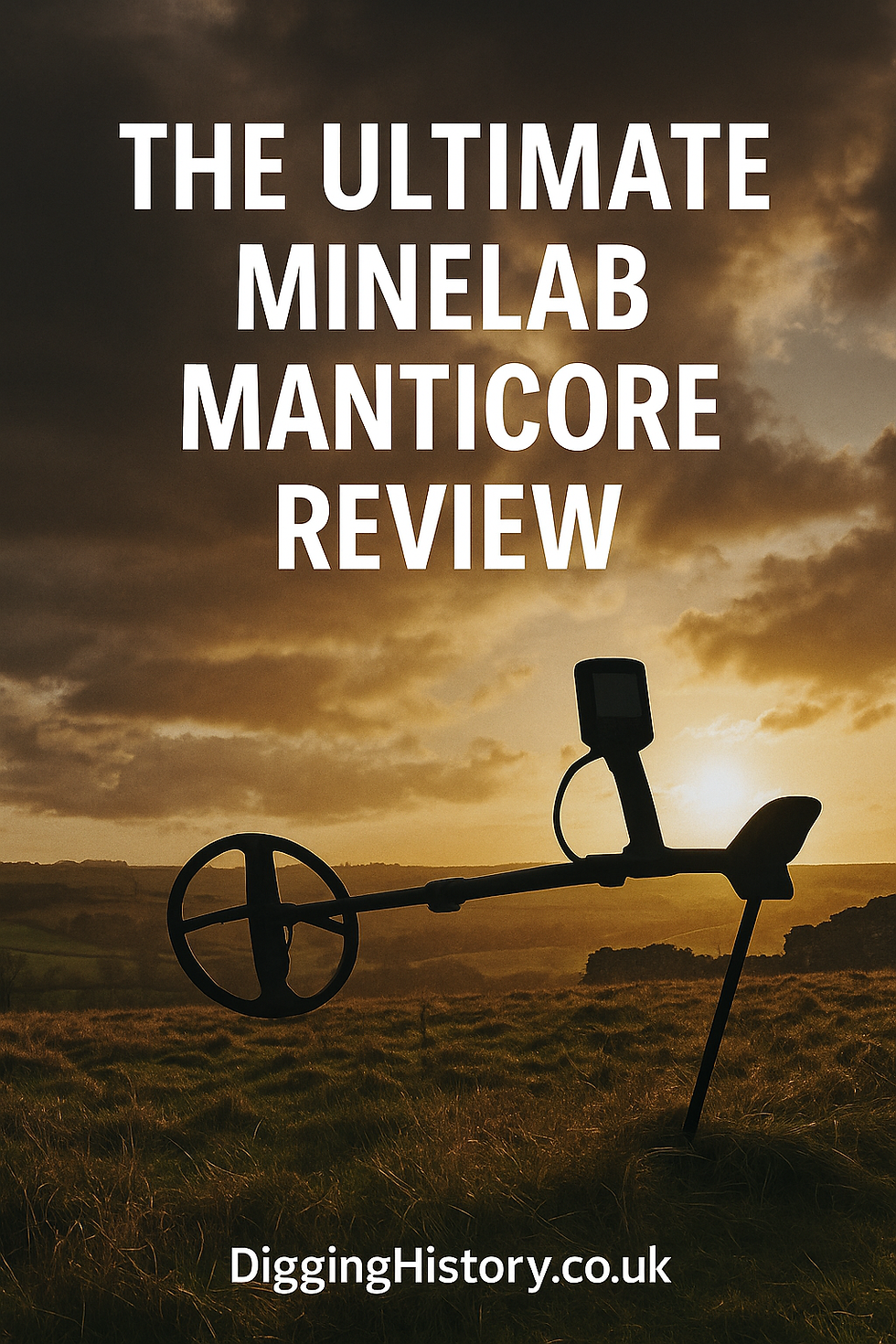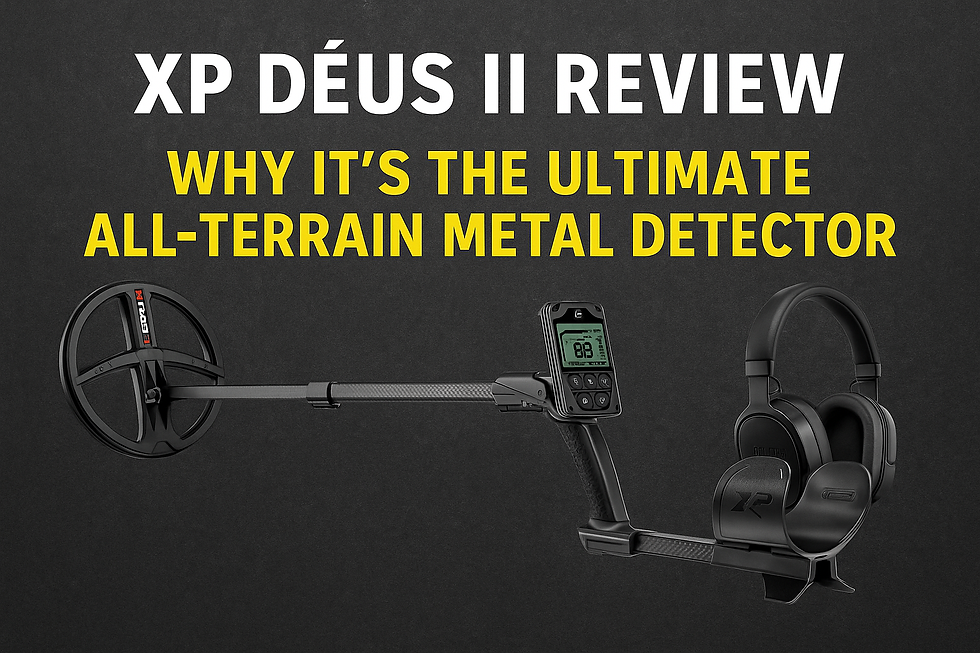Normans & High Medieval Britain (1066–1300) & Metal Detecting: The Ultimate Guide To Unearthing Norman Treasure UK
- DiggingHistory.co.uk
- Sep 23
- 5 min read
Conquest, Castles, and Coins Beneath Our Feet
When William of Normandy defeated Harold at the Battle of Hastings in 1066, Britain entered a new era. Norman lords built castles, monasteries, and cathedrals, reshaping the landscape. Over the following two centuries, the High Medieval period (c. 1100–1300), Britain saw the growth of towns, markets, and trade.
For detectorists, this era offers a rich harvest: Norman coins, horse harness pendants, brooches, pilgrim badges, merchant seals, and hoards. Castles, battlefields, abbeys, and medieval fairs left layers of artefacts waiting in the soil. Some of the UK’s most spectacular finds, like the Chew Valley Hoard (2019) date to this period.
This guide explores Norman and High Medieval Britain from a detectorist’s perspective: what was left behind, why it survives, famous discoveries, hotspots, and how to detect responsibly under UK law.

Norman & High Medieval Britain at a Glance (1066–1300)
1066 – William the Conqueror wins at Hastings; Norman rule begins.
1066–1100 – Norman consolidation; castles and cathedrals built.
12th century – Expansion of towns, markets, monasteries. Coinage develops.
1215 – Magna Carta signed, marking political tensions.
13th century – Edward I reforms coinage; long cross pennies dominate circulation.
1300 – England a feudal and commercial kingdom with bustling markets and trade routes.
Coins: From William the Conqueror to Edward I

Norman Pennies
William I (1066–1087) issued silver pennies with crude portraits.
Successors (William II, Henry I, Stephen) produced similar pennies, often poorly struck but abundant.
12th Century
Henry II standardised coinage with the short cross penny (c. 1180).
These circulated widely, and are a common detectorist find.
13th Century
Henry III introduced the long cross penny (1247), making coins harder to clip.
Edward I later reformed the system with high-quality pennies (1279 onwards), many of which survive in excellent condition.
Famous find:
Chew Valley Hoard (2019) – Over 2,500 silver coins of Harold II, William I, and William II, found by detectorists in Somerset. It revealed previously unknown coin types.
Brooches, Buckles & Dress Fittings

Medieval fashion left behind countless small metal objects:
Brooches – annular, disc, and cross-shaped brooches survive in copper alloy, silver, or gilt.
Belt buckles and strap ends – often decorated with animal or geometric motifs.
Pins and lace tags – everyday fasteners often lost in soil.
These are among the most common non-coin finds from Norman and medieval fields.
Pilgrim Badges & Religious Artefacts

The growth of pilgrimage in medieval England left a trail of distinctive finds:
Lead-alloy pilgrim badges depicting saints, relics, or shrines. Popular from Canterbury, Walsingham, and Santiago de Compostela.
Ampullae – small lead flasks for holy water, often stamped with cross motifs.
Cross pendants and reliquary fittings – showing Christianity’s deep hold.
Detectorists have found hundreds of such objects, many recorded in the Portable Antiquities Scheme (PAS) database.
Seals, Tokens & Trade Artefacts

Merchant Seals
Small lead seals stamped with merchant marks or family crests often turn up in fields near medieval towns.
Cloth Seals
Two-part lead seals used to mark cloth quality; common in trade centres.
Tokens
Lead or pewter tokens circulated in markets, often with simple cross or pellet designs.
These finds help map out medieval trade and market activity.
Horse Harness Pendants & Military Gear

Norman and medieval knights decorated their horses with enamelled harness pendants showing coats of arms or simple designs. Detectorists often recover:
Copper-alloy pendants (sometimes gilded).
Shield mounts.
Spurs and strap fittings.
These artefacts are diagnostic of the 12th–13th centuries and popular among detectorists.
Everyday Tools & Domestic Objects

Life in Norman and medieval villages left behind:
Keys and locks.
Knives with decorated handles.
Shears and agricultural tools.
Weights used in trade.
Gaming pieces of bone or lead.
Small losses like these paint vivid pictures of medieval daily life.
Famous Norman & Medieval Detectorist Finds
Chew Valley Hoard (Somerset, 2019)
Discovered by detectorists Lisa Grace and Adam Staples: over 2,500 silver pennies of Harold II, William I, and William II. It rewrote coinage history of the Norman Conquest.
Salisbury Pilgrim Badge Hoard (Wiltshire, 2016)
Detectorists uncovered a group of lead pilgrim badges near Old Sarum, shedding light on medieval pilgrimage.
Norfolk Harness Pendants (PAS)
Detectorists across Norfolk have reported dozens of enamelled harness pendants, many linked to knightly families.
Yorkshire Cloth Seals
PAS records reveal numerous lead cloth seals in Yorkshire, showing the region’s role in medieval textile trade.
Detecting the Norman & Medieval Landscape
Castles
While castles themselves are protected, surrounding fields often yield artefacts from military camps and trade activity.
Abbeys & Churches
Religious centres like Canterbury, Durham, and Walsingham produced pilgrim badges, ampullae, and offertory tokens.
Towns & Markets
Expanding towns left behind coin scatters, tokens, and seals. Surrounding farmland may still yield small finds.
Battlefields
Norman battle sites (e.g., Hastings 1066, Northallerton 1138) are scheduled, but their peripheries sometimes produce stray items.
Recognising Norman & Medieval Treasure UK
Coins: short cross, long cross, and Edwardian pennies.
Brooches: annular, disc, cross.
Pilgrim badges: lead-alloy, depicting saints or shrines.
Harness pendants: copper-alloy with enamel.
Seals: lead merchant or cloth seals.
Everyday items: knives, keys, weights, gaming pieces.
Laws & Responsible Detecting
England, Wales & NI – Treasure Act 1996
Two or more coins over 300 years old = Treasure.
Gold/silver artefacts over 300 years old = Treasure.
Must be reported to the coroner via your FLO.
Scotland – Treasure Trove
All significant finds claimable by the Crown.
Report to the Treasure Trove Unit.
Always:
Get written landowner permission.
Avoid detecting on scheduled monuments.
Record all finds with PAS or TTU.
What Norman & Medieval Finds Teach Us
Chew Valley Hoard – new insight into Norman coinage.
Pilgrim badges – devotional culture and long-distance travel.
Harness pendants – heraldry and knightly identity.
Cloth seals – booming medieval trade.
Domestic items – everyday life in villages and towns.
Practical Tips for Norman & Medieval Detecting
Research medieval place-names – look for “-caster”, “-minster”, “-market”.
Overlay historic maps with known castle and abbey sites.
Focus near rivers and trade routes.
Look for clusters of lead finds – often linked to trade or pilgrimage.
Expect worn pennies – even clipped or bent coins are valuable records.
FAQs
Where is Norman treasure most common in the UK? Across England, but especially near early Norman strongholds in the south and east.
What’s the biggest Norman coin hoard in Britain? The Chew Valley Hoard (2019) with over 2,500 coins of Harold II, William I, and William II.
Can detectorists find pilgrim badges? Yes — lead badges are regularly reported to the PAS from across England.
Are medieval finds Treasure? Coins and precious metal objects over 300 years old must be reported under the Treasure Act.
Knights, Pilgrims & Pennies Beneath the Soil
From William’s conquest to Edward I’s reforms, the Norman and High Medieval period reshaped Britain. Detectorists uncover pennies, brooches, badges, harness pendants, and hoards that tell stories of castles, crusades, markets, and monasteries.
Every Norman or medieval signal is a piece of that world, a pilgrim’s badge dropped on the road to Canterbury, a knight’s pendant lost in a field, a penny clipped and discarded at market. Detect responsibly, record diligently, and you’ll help illuminate Britain’s medieval past.
Thank You for Reading
Thank you for exploring the Norman and High Medieval era with us. From coins and brooches to pilgrim badges and hoards, every discovery adds to our understanding of Britain’s story.
👉 If you enjoyed this guide, please share it with fellow detectorists, history lovers, and friends. The more we share knowledge, the more we uncover together.





Comments